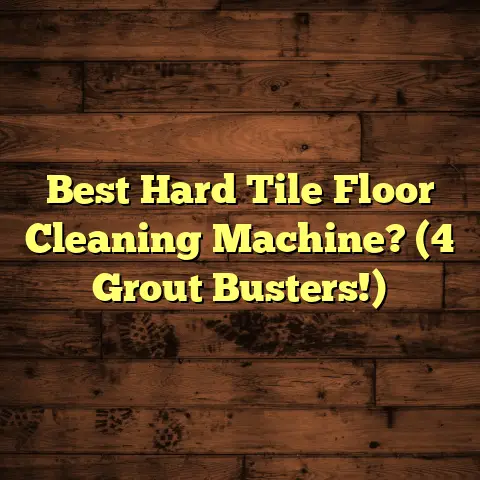Can I Use Spray Nine On Tile Floors? (Explained)
When it comes to maintaining tile floors, I’ve often found myself on the lookout for effective cleaning solutions. Tile floors are beautiful and durable, but they can be susceptible to stains, dirt, and grime, especially in high-traffic areas like kitchens and bathrooms. One product that has gained popularity for its cleaning prowess is Spray Nine, a versatile cleaner that promises to tackle a variety of surfaces effectively. In this article, I will share my personal experiences with Spray Nine, explore its suitability for tile floors, and provide insights into cleaning practices based on my journey.
Understanding Spray Nine: A Closer Look
Spray Nine is known as an all-purpose cleaner that can cut through tough grease, grime, and stains. It is formulated with a blend of surfactants, solvents, and detergents that work together to loosen and remove dirt. The product is often marketed for use in various settings, including homes, garages, and industrial environments.
Product Specifications
Before diving into my experiences, it’s essential to look at the technical specifications of Spray Nine:
- Active Ingredients: The cleaner contains surfactants for breaking down dirt and grease, along with other solvents that enhance its cleaning capabilities.
- pH Level: Spray Nine typically has a neutral pH, making it safe for various surfaces without causing damage.
- Packaging: It comes in different sizes, with the most common being a 32-ounce spray bottle.
- Odor: The cleaner has a strong chemical scent that some may find off-putting. I recommend using it in well-ventilated areas.
My Journey with Spray Nine on Tile Floors
Initial Considerations
When I first heard about Spray Nine, I was intrigued by its claims of being a multi-surface cleaner. However, my primary concern was whether it would be safe and effective on my ceramic tile floors. I decided to conduct a series of tests to evaluate its performance.
Testing Phase: Setting Up My Experiment
I chose several areas in my home with different tile types for my tests:
- Kitchen Tiles: These ceramic tiles had accumulated grease and food stains over time.
- Bathroom Tiles: The tiles here were porcelain and often had soap scum and mildew due to the humid environment.
- Entryway Tiles: These were natural stone tiles that had seen a lot of foot traffic and dirt.
For each test area, I prepared the tiles by sweeping and vacuuming to remove loose dirt before applying Spray Nine.
Results from the Kitchen
In the kitchen, I sprayed Spray Nine directly onto the tiles and let it sit for about five minutes before wiping it away with a damp mop. The results were impressive. The grease stains around the stove were significantly diminished, and the overall shine of the tiles was restored.
However, I noticed that some stubborn stains required a second application. This was not entirely unexpected, as years of buildup can be challenging to eliminate completely.
Bathroom Trials
Next up was the bathroom. I applied the same method: spraying the cleaner on the tiles and grout lines. To my surprise, Spray Nine effectively removed soap scum and mildew stains from the porcelain tiles. The grout lines were particularly rewarding; they looked much cleaner after just one application.
I did note that for areas with heavy mildew growth, I needed to let the product sit longer—up to ten minutes—to break down the buildup effectively.
Challenges Encountered
While my experiences were mostly positive, some challenges arose during my testing:
- Residue Problems: After cleaning, I found that some tiles had a slight residue if I didn’t rinse them thoroughly afterward. This prompted me to adjust my cleaning routine to include a final rinse with plain water.
- Compatibility Issues: On the natural stone tiles in my entryway, while Spray Nine did a decent job cleaning dirt and grime, I noticed some dulling of the surface finish after repeated use. This made me reconsider how often I would use it in that area.
Exploring Alternative Cleaning Solutions
After using Spray Nine for some time, I decided to compare it with other cleaning methods I had previously tried:
Vinegar and Water Solution
One popular DIY solution is mixing vinegar with water. I’ve used this method before for general cleaning tasks. While vinegar is a natural disinfectant and deodorizer, I found it less effective against tough stains compared to Spray Nine.
- Effectiveness: Vinegar works well for light cleaning but struggled with greasy stains and heavy grime.
- Cost: A gallon of vinegar costs about $3, making it a budget-friendly option.
- Ease of Use: Mixing vinegar with water is easy; however, you may need to scrub more vigorously than when using a commercial cleaner.
Commercial Tile Cleaners
I also explored other commercial tile cleaners available in stores:
- Specific Tile Cleaners: Many brands offer cleaners specifically formulated for tile surfaces. These often come at a higher price point (around $15-$25 per bottle) but promise enhanced effectiveness on particular types of tiles.
- Performance Comparison: In my experience, while these products often claim to be superior for tile maintenance, they didn’t always outperform Spray Nine in terms of versatility across different surfaces.
Practical Tips for Using Spray Nine on Tile Floors
Based on my experiences with Spray Nine, here are some practical tips to ensure effective cleaning:
- Always Test First: Before using Spray Nine on your tile floors, test it in a small hidden area to ensure compatibility with your specific tile type.
- Adjust Dilution Ratios: For regular maintenance, consider diluting Spray Nine according to the instructions. For tough stains or heavy residue, use it undiluted but follow up with rinsing.
- Use Proper Tools: Pair Spray Nine with microfiber cloths or mops for optimal results. Avoid abrasive materials that might scratch your tile surfaces.
- Ventilation is Key: Since Spray Nine has a strong chemical odor, ensure proper ventilation when using it to avoid inhaling fumes.
- Frequency of Cleaning: Establish a regular cleaning schedule based on foot traffic and usage patterns to prevent heavy buildup that requires more intensive cleaning.
Analyzing Long-Term Use
After months of using Spray Nine on various tile surfaces throughout my home, I’ve come to appreciate both its strengths and limitations.
Advantages of Using Spray Nine
- Versatility: It works well on multiple surfaces beyond just tile—metal, glass, and fabric—making it a great all-purpose cleaner.
- Time Efficiency: My cleaning time has reduced significantly since using Spray Nine regularly.
- Cost-Effective: Given its effectiveness and price point, it’s an economical choice compared to hiring professional cleaners or purchasing multiple specialized products.
Disadvantages Noted
- Potential Residue: If not rinsed properly after use, residue can build up on surfaces over time.
- Impact on Natural Stone: Caution is advised when using it on sensitive surfaces like natural stone since repeated use can dull finishes.
Maintenance of Tile Floors Beyond Cleaning
While effective cleaning is crucial for tile maintenance, there are other essential factors to consider:
Regular Sealing
For natural stone tiles, sealing is vital to prevent staining and damage from moisture. I learned this lesson when my unsealed tiles started absorbing spills more easily than expected.
- Sealing Frequency: Depending on the type of stone and usage, seals may need reapplication every 1-3 years.
- Sealant Types: There are penetrating sealers which soak into the stone and surface sealers which create a protective layer on top.
Grout Maintenance
Grout lines can be particularly prone to staining over time due to their porous nature. Here are some strategies I’ve adopted:
- Regular Cleaning: Use targeted grout cleaners or concentrated vinegar solutions for routine maintenance.
- Grout Sealing: After deep cleaning grout lines, sealing them can protect against future stains and make maintenance easier.
Conclusion: Weighing My Options
Throughout my journey with Spray Nine on tile floors, I’ve gathered valuable insights into its effectiveness as a cleaning solution. While it proved beneficial in many ways—especially for tough stains—it also highlighted the importance of proper usage techniques and regular maintenance habits.
When comparing Spray Nine with other cleaning options like vinegar or specialized commercial cleaners, I found that it holds its ground well due to its versatility and effectiveness across different surfaces. However, it’s essential to consider the specific needs of your flooring type before settling on any one product as your go-to cleaner.
In the end, maintaining tile floors involves more than just finding the right cleaner; it requires a balanced approach that includes regular upkeep, sealing where necessary, and understanding how different products interact with your specific flooring materials. As I continue my journey in home maintenance, I’ll keep refining my methods based on what works best in practice!





